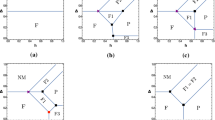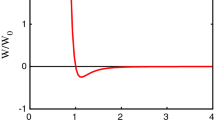Abstract.
Systems with long-range interactions can reach a Quasi Stationary State (QSS) as a result of a violent collisionless relaxation. If the system mixes well (ergodicity), the QSS can be predicted by the statistical theory of Lynden-Bell (1967) based on the Vlasov equation. When the initial condition takes only two values, the Lynden-Bell distribution is similar to the Fermi-Dirac statistics. Such distributions have recently been observed in direct numerical simulations of the HMF model (Antoniazzi et al. 2006). In this paper, we determine the caloric curve corresponding to the Lynden-Bell statistics in relation with the HMF model and analyze the dynamical and thermodynamical stability of spatially homogeneous solutions by using two general criteria previously introduced in the literature. We express the critical energy and the critical temperature as a function of a degeneracy parameter fixed by the initial condition. Below these critical values, the homogeneous Lynden-Bell distribution is not a maximum entropy state but an unstable saddle point. Known stability criteria corresponding to the Maxwellian distribution and the water-bag distribution are recovered as particular limits of our study. In addition, we find a critical point below which the homogeneous Lynden-Bell distribution is always stable. We apply these results to the situation considered in Antoniazzi et al. For a given energy, we find a critical initial magnetization above which the homogeneous Lynden-Bell distribution ceases to be a maximum entropy state. For an energy U=0.69, this transition occurs above an initial magnetization Mx=0.897. In that case, the system should reach an inhomogeneous Lynden-Bell distribution (most mixed) or an incompletely mixed state (possibly fitted by a Tsallis distribution). Thus, our theoretical study proves that the dynamics is different for small and large initial magnetizations, in agreement with numerical results of Pluchino et al. (2004). This new dynamical phase transition may reconcile the two communities by showing that they study different regimes.
Similar content being viewed by others
References
Dynamics and Thermodynamics of Systems with Long Range Interactions, edited by T. Dauxois, S. Ruffo, E. Arimondo, M. Wilkens, Lect. Not. in Phys. 602 (Springer, 2002)
T. Konishi, K. Kaneko, J. Phys. A 25, 6283 (1992)
S. Inagaki, T. Konishi, Publ. Astron. Soc. Jpn 45, 733 (1993)
C. Pichon, Ph.D. thesis, Cambridge (1994)
M. Antoni, S. Ruffo, Phys. Rev. E 52, 2361 (1995)
V. Latora, A. Rapisarda, C. Tsallis, Phys. Rev. E 64, 056134 (2001); V. Latora, A. Rapisarda, C. Tsallis, Physica A 305, 129 (2002)
M.Y. Choi, J. Choi, Phys. Rev. Lett. 91, 124101 (2003)
A. Pluchino, V. Latora, A. Rapisarda, Physica D 193, 315 (2004)
Y.Y. Yamaguchi, J. Barré, F. Bouchet, T. Dauxois, S. Ruffo, Physica A 337, 36 (2004)
F. Bouchet, Phys. Rev. E 70, 036113 (2004)
C. Anteneodo, R.O. Vallejos, Physica A 344, 383 (2004)
P.H. Chavanis, J. Vatteville, F. Bouchet, Eur. Phys. J. B 46, 61 (2005)
H. Morita, K. Kaneko, Phys. Rev. Lett. 94, 087203 (2005)
T.M. Rocha Filho, A. Figueiredo, M.A. Amato, Phys. Rev. Lett. 95, 190601 (2005)
A. Rapisarda, A. Pluchino, Europhysics News 36, 202 (2005)
F. Bouchet, T. Dauxois, Phys. Rev. E 72, 045103(R) (2005)
P.H. Chavanis, Eur. Phys. J. B 52, 47 (2006)
A. Campa, A. Giansanti, D. Mukamel, S. Ruffo, Physica A 365, 120 (2006)
A. Pluchino, A. Rapisarda, Physica A 365, 184 (2006)
L.G. Moyano, C. Anteneodo, Phys. Rev. E 74, 021118 (2006)
F. Baldovin, E. Orlandini, Phys. Rev. Lett. 96, 240602 (2006)
P.H. Chavanis, Statistical Mechanics of Two-dimensional Vortices and Stellar Systems in dauxois, arXiv:[cond-mat/0212223]
P.H. Chavanis, Physica A 361, 55 (2006); P.H. Chavanis, Physica A 361, 81 (2006)
C. Tsallis, J. Stat. Phys. 52, 479 (1988)
P.H. Chavanis, Physica A 365, 102 (2006)
A. Antoniazzi, D. Fanelli, J. Barré, P.H. Chavanis, T. Dauxois, S. Ruffo, arXiv:[cond-mat/0603813v2]
D. Lynden-Bell, MNRAS 136, 101 (1967)
P.H. Chavanis, J. Sommeria, R. Robert, ApJ 471, 385 (1996)
P.H. Chavanis, Contributions à la mécanique statistique des tourbillons bidimensionnels. Analogie avec la relaxation violente des systèmes stellaires, Ph.D. thesis, ENS Lyon (1996)
P.H. Chavanis, Statistical Mechanics of Violent Relaxation in Stellar Systems, in Proceedings of the Conference on Multiscale Problems in Science and Technology, edited by N. Antonic, C.J. van Duijn, W. Jager, A. Mikelic (Springer, Berlin, 2002) arXiv:[astro-ph/0212205]
P.H. Chavanis, Physica A 359, 177 (2006)
P.H. Chavanis, J. Sommeria, MNRAS 296, 569 (1998)
P.H. Chavanis, Phys. Rev. E 68, 036108 (2003)
J. Binney, S. Tremaine, Galactic Dynamics (Princeton Series in Astrophysics, 1987)
P.H. Chavanis, A&A 401, 15 (2003)
S. Tremaine, M. Hénon, D. Lynden-Bell, MNRAS 227, 543 (1986)
P.H. Chavanis, C. Sire, Physica A 356, 419 (2005)
P.H. Chavanis, A&A 451, 109 (2006)
J. Miller, Phys. Rev. Lett. 65, 2137 (1990)
R. Robert, J. Sommeria, JFM 229, 291 (1991)
P.H. Chavanis, A&A 381, 340 (2002)
P.H. Chavanis, M. Lemou, Phys. Rev. E 72, 061106 (2005)
P.H. Chavanis, Eur. Phys. J. B 52, 61 (2006)
A. Pluchino, A. Rapisarda, Prog. Theor. Phys. Supp. 162, 18 (2006)
A.R. Plastino, A. Plastino, Physica A 222, 347 (1995)
C. Tsallis, D.J. Bukman, Phys. Rev. E 54, R2197 (1996)
P.H. Chavanis, Physica A 332, 89 (2004); P.H. Chavanis, Physica A 340, 57 (2004)
H. Brands, P.H. Chavanis, R. Pasmanter, J. Sommeria, Phys. Fluids 11, 3465 (1999)
P.H. Chavanis, J. Sommeria, J. Fluid Mech. 314, 267 (1996)
I. Arad, D. Lynden-Bell, MNRAS 361, 385 (2005)
R. Ellis, K. Haven, B. Turkington, Nonlinearity 15, 239 (2002)
P.H. Chavanis, Physica D 200, 257 (2005)
P.H. Chavanis, Statistical Mechanics of 2D Turbulence with a Prior Vorticity Distribution, in Proceedings of the Workshop on Interdisciplinary Aspects of Turbulence at Ringberg Castle, Tegernsee, Germany (Max-Planck Institut fur Astrophysik, 2005) arXiv:[physics/0601087]
N. Leprovost, B. Dubrulle, P.H. Chavanis, Phys. Rev. E 73, 046308 (2006)
X.P. Huang, C.F. Driscoll, Phys. Rev. Lett. 72, 2187 (1994)
B.M. Boghosian, Phys. Rev. E 53, 4754 (1996)
P.H. Chavanis, MNRAS 300, 981 (1998)
B.B. Kadomtsev, O.P. Poguste, Phys. Rev. Lett. 25, 1155 (1970)
W. Braun, K. Hepp, Commun. Math. Phys. 56, 101 (1977)
P.H. Chavanis, Phys. Rev. E 65, 056123 (2002)
Author information
Authors and Affiliations
Corresponding author
Rights and permissions
About this article
Cite this article
Chavanis, P. Lynden-Bell and Tsallis distributions for the HMF model. Eur. Phys. J. B 53, 487–501 (2006). https://doi.org/10.1140/epjb/e2006-00405-5
Received:
Published:
Issue Date:
DOI: https://doi.org/10.1140/epjb/e2006-00405-5




